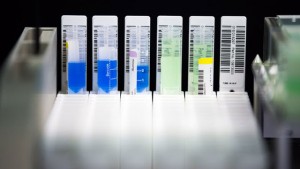 Steven Pete can put his hand on a hot stove or step on a piece of glass and not feel a thing, all because of a quirk in his genes. Only a few dozen people in the world share Pete’s congenital insensitivity to pain. Drug companies see riches in his rare mutation. They also have their eye on people like Timothy Dreyer, 25, who has bones so dense he could walk away from accidents that would leave others with broken limbs. About 100 people have sclerosteosis, Dreyer’s condition.
Steven Pete can put his hand on a hot stove or step on a piece of glass and not feel a thing, all because of a quirk in his genes. Only a few dozen people in the world share Pete’s congenital insensitivity to pain. Drug companies see riches in his rare mutation. They also have their eye on people like Timothy Dreyer, 25, who has bones so dense he could walk away from accidents that would leave others with broken limbs. About 100 people have sclerosteosis, Dreyer’s condition.
Both men’s apparent superpowers come from exceedingly uncommon deviations in their DNA. They are genetic outliers, coveted by drug companies Amgen, Genentech, and others in search of drugs for some of the industry’s biggest, most lucrative markets.
Their genes also have caused the two men enormous suffering. Pete’s parents first realized something was wrong when, as a teething baby, their son almost chewed off his tongue. “That was a giant red flag,” says Pete, now 34 and living in Kelso, Wash. It took doctors months to figure out he had congenital insensitivity to pain, caused by two different mutations, one inherited from each parent. On their own, the single mutations were benign; combined, they were harmful.
Dreyer, who lives in Johannesburg, was 21 months old when his parents noticed a sudden facial paralysis. Doctors first diagnosed him with palsy. Then X-rays revealed excessive bone formation in his skull, which led to a diagnosis of sclerosteosis. Nobody in Dreyer’s family had the disorder; his parents both carried a single mutation, which Dreyer inherited.
Dreyer and Pete are “a gift from nature,” says Andreas Grauer, global development lead for the osteoporosis drug Amgen is creating. “It is our obligation to turn it into something useful.”
What’s good for patients is also good for business. The painkiller market alone is worth $18 billion a year. The industry is pressing ahead with research into genetic irregularities. The U.S. Food and Drug Administration is expected to approve a cholesterol-lowering treatment on July 24 from Sanofi and Regeneron Pharmaceuticals based on the rare gene mutation of an aerobics instructor with astoundingly low cholesterol levels. Amgen has a similar cholesterol drug, based on the same discovery, and expects U.S. approval in August. The drugs can lower cholesterol when statins alone don’t work. They are expected to cost up to $12,000 per patient per year and bring in more than $1 billion annually.
Read the full report at BLOOMBERG.
{Matzav.com Newscenter}












A little misleading on the cost of the drugs. The charge to the consumer may be $12,000 a year, but the cost to the drug company is much much lower. This cost to the consumer is huge over charge and is nothing more than price gouging. There should be a law….
Inability to feel pain or “Protective sensation”is not something to be desired.Ask any diabetic with diabetic ulcers on their feet.This article sounds like a lot of nonsense